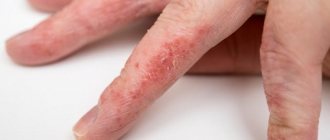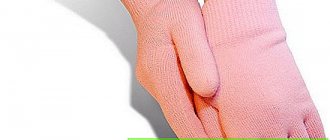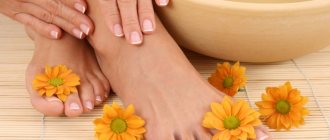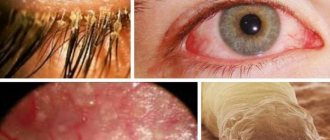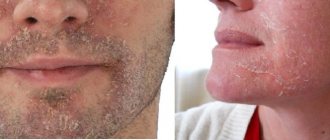What is dry skin
Dry skin means a constant feeling of tightness, tingling, peeling, and cracks on the hands. The surface of the skin on the back of the hands and palms becomes rough, inelastic, especially stretched after contact with water and soap. Household chores can cause even more harm in this situation, so it is important to use special gloves when washing dishes and cleaning.
The epidermis on the hands is thinner, has no sebaceous glands at all, and contains little moisture, unlike the skin of the face. Adverse weather conditions, contact with allergens, constant washing with hot water, failure to follow basic daily rules of personal care, all this leads to dry skin on the hands. What reasons can be identified:
- cold: if you don’t wear gloves in low temperatures, the skin will definitely become rough,
- household chemicals: wash dishes, windows, do wet cleaning only with gloves,
- rough work with bare hands,
- congenital predisposition,
- nutritional disorders, lack of vitamins, dermatological diseases.
Reasons why the skin on the fingers, pads, tips, folds, and knuckles cracks
There are many factors that lead to this problem. Severe dry hands can be caused by both external and internal causes. Before you start getting rid of cracks, you need to find out why they appear and do not go away.
External reasons
The occurrence of such a problem is explained by the fact that the skin on the hands becomes very dry and lacks moisture. This happens for various reasons, the most common of which are various external influences.
For example, one of the most common factors leading to the appearance of numerous cracks on fingers is frequent and prolonged contact with water or household chemicals. Many women have probably noticed that after washing dishes with special products, their skin becomes dry.
The mechanism by which cracks occur is quite simple: upon contact with water, the pores begin to open. This, in turn, clears the way for harmful substances contained in household chemicals.
Expert opinion
Tatyana Somoilova
Cosmetology expert
To avoid cracks from using detergents, it is recommended to wear household gloves when doing household chores. And after cleaning is completed, your hands should be lubricated with a nourishing cream that will sufficiently moisturize the skin.
In addition to household chemicals and water, various weather conditions negatively affect the condition of your hands. In the summer, when it is very hot outside, the body tries to regulate its temperature on its own. Sweating increases, which leads to noticeable loss of moisture. Therefore, on hot days it is also necessary to take care of the skin of your hands.
In winter, when the temperature drops significantly and cold winds blow, again there is a high probability of cracks on the fingers. If you don't insulate your hands and leave them exposed to the frosty air, you can get flaky skin. At the same time, it can crack not only on the fingers and their pads, but also on the back of the hand. At this time of year, your hands especially need hydration.
Cracks can also appear due to incorrectly selected cosmetics. Cheap and low-quality products can only harm the skin. Therefore, the choice of creams, scrubs, masks should be approached with all responsibility.
To understand whether external factors played a decisive role in the appearance of cracks, you need to analyze your actions over the past couple of weeks. For example, if the cause of dry skin is frequent contact with household chemicals, it is better to start using gloves.
You should try to avoid exposure to these external factors. If this does not help, and cracks continue to appear on the fingers and palms, you should consult a doctor. Perhaps they are caused by pathological processes in the body itself.
Internal reasons
Cracks can appear due to various health problems. In such cases, they are most often localized on the skin between the fingers, at their very tips or on the inside of the palm.
If eliminating exposure to external factors does not help, you should consult a doctor. One of the most common causes of cracks on the hands is fungus. In this case, an infection penetrates the skin and its metabolism is disrupted. This causes excessive dryness. Severe itching and burning may also indicate the presence of a fungal infection.
Another reason for cracks is vitamin deficiency. If the body does not receive all the necessary minerals and beneficial microelements, many of its systems begin to work worse. This also applies to the skin, because many vitamins are required to generate epidermal cells and maintain its elasticity. To avoid dry skin, you should include fresh fruits and vegetables in your diet.
Eczema on fingers
Eczema can also serve as an internal factor contributing to the appearance of cracks in the fingers. In terms of its symptoms, this disease is very similar to a fungal infection. But in addition to the signs already noted, swelling and various thickening of the skin in the affected areas may also occur.
In addition, cracks on the hands may indicate an allergic reaction to any household products, food or even cosmetics. Their appearance can also be caused by hormonal imbalances in the body or problems with the gastrointestinal tract and pancreas.
Expert opinion
Tatyana Somoilova
Cosmetology expert
If internal factors are the cause of cracks in your fingers and palms, you should consult a doctor as soon as possible. You should also remember that you should not self-medicate. This will not only not get rid of the problem, but will also aggravate it even more.
Causes of dry hand skin
The skin on your hands can be dry for several reasons, including:
- weather conditions: in frost and cold winds, the skin of the hands becomes rough, redness and cracks may appear on it, and in the summer heat the skin quickly dehydrates and loses elasticity,
- damage: cuts, bruises, scratches,
- low humidity in the room due to heating devices being turned on, which negatively affects the skin of the hands,
- detergents that destroy the top protective layer of the skin and lead to allergies or dermatitis,
- too hot water, which dries out the natural oils on the skin,
- constant lack of vitamins A, E, C in the body or general vitamin deficiency, which often occurs in the winter-spring period,
- taking certain medications.
- Natural influences: excessive exposure to the sun, strong wind, cold - can destroy the epidermis and dry the skin.
- Daily hygiene with tap water saturated with chlorine and other chemicals also does not benefit the skin.
- Poor nutrition, seasonal vitamin deficiency and general vitamin deficiency, stress.
- Age factors.
In order to get rid of dryness on the face, the skin needs nutrition and hydration, but not all industrial products are able to provide it with them. Most contain many chemicals and have superficial and short-term effects. The most effective are folk recipes. The best recipes are masks you make yourself.
Rules for using masks
- The mask should be prepared just before use. Do not make them in advance and for future use; their effectiveness decreases during storage.
- The mask is always applied to a clean face. Before use, it is advisable to carry out the cleansing procedure with soft natural products: hydrophilic oil or micellar water.
- Oily masks for dry skin do not require the use of cream afterwards, but masks that tighten and have lifting properties do.
- Tone your skin after using masks.
- All recipes for dry skin should be alternated to achieve the best results. Do not always use the same recipe, try different products and their combinations, only in this way, through experimentation, can you understand which masks the skin responds to best.
- Natural masks have no contraindications and do not cause harm. The only exceptions are allergic reactions. If you are allergic to honey, citrus fruits or any other product, do not apply it to your skin.
Internal effects on the body will help enhance the effect of homemade masks. Try to eat right, take vitamins, walk outdoors more often and your skin will thank you with beauty and radiance.
Causes of cracks in the skin
The most likely reason for the formation of cracks is a weak protective skin barrier , which is not able to withstand an aggressive external environment. It consists of oils, proteins and other substances that help the skin from drying out and becoming very rough.
The most likely external causes that lead to the disappearance of the skin barrier can be considered:
- exposure to the cold without gloves;
- frequent overheating in the sun;
- sudden changes in temperature;
- dry indoor air;
- frequent contact with harsh chemicals or detergents;
- using care products that have expired.
If the main factor for dry skin is one of the external irritants, then shallow cracks will appear on the hands. In this case, damage does not occur between the fingers and at their tips.
However, there are a number of internal factors that affect the condition of the skin:
- skin diseases of infectious and non-infectious etiology;
- metabolic disorders;
- a number of endocrine diseases;
- allergic reactions;
- poor nutrition, which leads to a lack of vitamins and minerals;
- diseases of the digestive tract;
- Schegner's or Reiter's syndrome;
- age-related changes.
The main place of localization when exposed to internal factors is the area between the fingers, fingertips, and palms. Gradually the number of cracks increases and they spread throughout the arm.
In order to choose the right therapy , you need to establish the main cause that caused peeling and dry skin. Only after it has been eliminated will it be possible to begin complex treatment of the problem.
Treatment with pharmaceuticals
Cosmetics offered in pharmacies are good because they contain a ready-made set of active ingredients, the effect of which has been clinically proven. The downside is the high cost of such products and the unlikely but possible allergy. However, if you don’t want to bother with preparation, treatment with pharmaceutical products is also a solution: they can thoroughly moisturize the skin and protect it from the aggressive effects of the external environment. If you follow the instructions on the packaging and use the cream regularly, the development and renewal of skin cells will begin quickly.
What remedies are effective:
- French cosmetics Vichy, La Roche Posay, Eucerin, Lierac,
- ingredients for homemade creams: glycerin, paraffin, wax, herbal preparations, healthy oils,
- vitamins A and E in capsules: for oral administration and dilution with oil.
The knuckles are peeling
Try locobase cream, the best is locobase ripea. It heals the skin very well and helps with dryness.
And don’t forget about the usual recommendations: drink more water, take vitamins, try to keep your hands in mittens in the cold, do housework with gloves.
Regular hand cream helps me, but I need to apply it twice a day, which is the minimum! And not in a thin layer, but rather a large amount and wait until it is absorbed, it happened that before going to bed I applied the cream to my hands and within three hours it was absorbed, if you do this for 2 weeks, you yourself will notice how the skin softens, especially in autumn-winter it is important.
As you know, hands can tell much more about a woman than her face or even her eyes. A woman’s age, habits, state of health - all this can be read from her hands. Therefore, peeling skin on the fingers and the appearance of cracks become a real problem for the fair half of humanity.
Beautiful well-groomed hands adorn not only women, but also men. And it's not about the manicure at all. Dry skin, flaky palms - all this can stand out against the background of attractive facial features and fashionable clothes. Dryness is not just an aesthetic problem. If the skin on your fingers cracks, the likelihood of infection increases.
Factors that contribute to dry hands can be divided into two broad groups. External factors include the negative influence of the environment and objects with which you have to come into contact. Many people have noticed that the skin in general becomes drier and cracks during the seasonal cold. The reasons can be very diverse.
External factors include contact with hard water, chemicals, paint, and decorative cosmetics. At the same time, the condition of the skin of the hands can worsen not only in winter, but also in summer. The problem initially manifests itself as peeling. If treatment is not started, cracks in the hands and palms will inevitably appear.
The condition of the skin of the hands is a reflection of the internal health of the body
Internal factors include various fungal diseases, inflammatory processes caused by one or another inflammatory disease. Lack of vitamins in the body, hormonal imbalance - all this can also cause peeling of the skin of the hands and the appearance of painful cracks. Internal factors are those caused by health conditions. The problem now needs to be solved radically. Treatment cannot be reduced to the use of moisturizing cosmetics alone.
If the skin on your hands peels for a long time and it is not possible to restore the water balance with the help of creams, you should consult a dermatologist.
Metabolic disorders in the body can also lead to changes in the nature of the skin on the hands. Most often this happens with diseases of the gastrointestinal tract. The body can no longer fully receive vitamins and microelements from food. As a result, the skin dries out and the appearance of the hands deteriorates.
Remedy for dry hands
Peeling of the hands can cause a lot of discomfort, both aesthetic and internal, since the skin becomes more vulnerable, exposed to external factors. A good remedy for dry hand skin, paraffin baths and wax masks, which can be made at home, if you have the necessary ingredients, or from a specialist for a small amount.
Cream for dry hands
Creams prepared at home are natural and harmless, but they can be stored for a short time, up to 2 weeks, and in some cases they can cause allergies if the composition is incorrectly selected. Beeswax, paraffin, fish or pork fat, butter and glycerin work well for the base of a homemade cream for dry hands. The product must necessarily contain essential oils and other natural emollients.
It is better to apply cream for chapped hands at night for better effect, to maximally moisturize your hands and prevent the appearance of new cracks. Here are homemade recipes you may need:
- Butter – 2 tbsp. l., 1 tsp. honey, 1 tbsp. l. St. John's wort decoction. Store in the refrigerator, rub into the skin of your hands daily before bed.
- A solution containing vitamins A and E – 1 tsp, 1 tsp. any honey, 1 tsp. fresh lemon juice, 1 tsp. oil, preferably olive, 1 tsp. low-fat cream. Apply with a cotton pad.
- Night cream, to be applied and kept under gloves: 1 tbsp. l. strong green tea, 1 tsp. shea butter, 1 tsp. orange oil, 1 tsp. beeswax, 2 capsules of a vitamin complex (for example, aevit). Heat the mixture in a water bath, stir, and cool.
- A mixture of herbs (chamomile, celandine, St. John's wort) - 2 tbsp. l., pour half a glass of boiling water, leave for half an hour. Mix 2 tsp. sea buckthorn oil, 3 tbsp. l. melted wax, half a teaspoon of propolis and strained tincture. Apply in the morning and before bed.
- Glycerin – 4 tbsp. l., 3 tsp. lemon juice, 3 tsp. starch, 2 tbsp. l. vodka. Heat in a water bath, stir, cool, use every day.
- Take a tablespoon of cocoa butter, 3 drops of bitter orange oil, half a teaspoon of cinnamon. Mix, heat, beat with a fork or whisk, cool.
Hand oil for dry hands
Oils are a natural source of moisturizing and nourishing the skin. If you eat the right amount of fatty foods, add natural oils to cereals and salads, you can get the necessary fats to maintain softness and balance of the skin. Hand oil for dry hands can be used as part of masks or in its pure form. Regular care with oils will help your skin stay smooth during cold periods. Which oils are effective:
- Cacao butter. Can be applied solid or melted.
- Shea butter, coconut, natural cream.
- Nourishing mask: a teaspoon each of avocado, grape seed, almond, apricot, orange, olive oils. Mix, heat slightly, treat especially damaged areas of the hands and elbows.
Ointment for dry skin of hands
If the situation is serious and your hands become very dry and crack, daily, careful care may be required. Cracks and dryness can occur over time, in old age, especially if you previously engaged in rough physical labor (work in the garden, in production). You need to start dealing with this problem on time - with the help of daily care, help the skin return to a soft, delicate state, do not forget to use creams and protective gloves. What ointments for dry hand skin will you need:
- From calendula: grind half a glass of dry plant into powder using a blender or by hand, add a glass of melted lard. Heat in a water bath, stir, cool, store in the refrigerator.
- Mix plantain powder with a teaspoon of any oil and a tablespoon of Vaseline.
- Grind homemade rose petals into a pulp, mix with lard, leave for several days.
- Smooth hernia: combine 100 g of crushed plant and 2 tbsp. olive or almond oil. Infuse for a week.
Healing and caring creams
Using medicinal creams based on natural ingredients to care for your hand skin will help maintain its health and youth.
To prepare medicinal or caring creams - moisturizing or nourishing - both ready-made neutral creams and individual natural ingredients can be used.
Healing cream based on butter, herbal infusion, honey, base and essential oils of hyssop, geranium and ylang-ylang
- 50 g butter;
- 20 ml honey (not crystallized);
- 10 ml apricot kernel oil;
- 3 drops each of hyssop, geranium and ylang-ylang oils.
Melt butter, honey and base malt in a water bath and mix. Add essential oils to the mixture and beat using a mixer to prepare cosmetics. The resulting cream must be stored in the refrigerator in a glass container with a well-closing lid. Shelf life – 1 month.
Nourishing cream based on coconut and olive oil, beeswax, vitamin E and ylang-ylang essential oil
- 100 ml olive oil (extra virgin);
- 50 g beeswax;
- 50 ml coconut oil;
- 20 drops of ylang-ylang oil;
- 2.5 ml vitamin E.
Base oils and beeswax are melted in a water bath and an oil solution of vitamin E and essential oil are added to the warm mixture. The cream is placed in a glass container and stored in the refrigerator.
The shelf life depends on the shelf life of the components of the cosmetic product.
Moisturizing cream based on chamomile infusion, shea butter, jojoba and orange essential oil
- Concentrated chamomile decoction of 2 tablespoons of flowers and 100 ml of water;
- 5 ml shea butter;
- 10 ml jojoba oil;
- 4 drops of orange oil.
Shea butter and jojoba oil are placed in a glass container and beaten with a mixer. Add essential oil to the oil mixture and repeat the beating procedure. The resulting mixture of oils is mixed with chamomile decoction and beaten with a mixer for 10 minutes.
Anti-aging cream based on vitamins A and E, salicylic acid and cinnamon essential oil with exfoliating properties
- 1 teaspoon salicylic acid;
- 2.5 ml of vitamin A and E;
- 3 drops of cinnamon oil.
All components are mixed until smooth. The cream is applied to areas of pigmentation once a day for 5-6 days.
Masks for rough, very dry hand skin
You can prepare nutritious and healthy hand masks at home. It doesn't take much time to make them.
- For very dry hand skin, sunflower oil is suitable. It should be applied to your hands and gloves should be worn on top.
- Mashed potatoes made with milk. It should be applied to hands while warm.
- Separate the white from the yolk. Take half the yolk, beat it and add an arbitrary amount of olive oil. Lubricate the skin, combining application with massage.
Honey hand masks
A hand mask for very dry skin made from honey is one of the most effective and efficient.
- Honey mixed with chicken yolk will help make the hands soft and soothe the epidermis. To prepare the mixture, you need to mix raw egg yolk with 15 ml of vegetable oil. Add honey and three drops of lemon to the resulting mixture. Apply the mixture to your hands, put on cotton gloves and, if possible, leave overnight.
- The second version of the mask is to take 15 ml of honey, mix it with yolk and 5 g of oatmeal. Spread the mixture for two hours. After the first procedure, the epidermis on your hands will become soft and tender.
- Mix honey and olive oil in a ratio of 3 parts to 1. Add a couple of drops of lemon juice to this mixture. Apply to the epidermis of the hands, put on gloves on top and rinse off the next morning. Repeat at least twice a week.
Parsley hand masks
To prepare the mixture, you will need a teaspoon of parsley juice, which can be obtained using a juicer or a meat grinder. To extract juice using a meat grinder, after the parsley has been passed through it, the juice must be squeezed out using gauze.
In addition to the juice, you will need fish oil in the amount of three capsules and 15 g of high-fat cottage cheese. Spread the mixture on the skin of your hands and rinse with warm water after a quarter of an hour.
From potatoes
Boil two potatoes, crush with the addition of milk (45 ml) and butter (15 ml). Apply the resulting mass to your hands and, after 20 minutes, rinse.
From lemon
Lemon-based masks both nourish and soften the skin.
- Take oatmeal (2 tbsp), add a large spoon of water and sunflower oil. To all of the above, add 5 ml of glycerin and the same amount of lemon juice. Spread on hands. After removing the mask, the skin will become soft.
- In the summer, to ensure that your hands are not only soft and tender, but also without pigment spots, it is recommended to use the following recipe. Make melon puree and squeeze the juice of half a lemon into it. Add enough starch to obtain a mushy consistency. Apply to hands.
- Boil a couple of potatoes in their skins and add 10 ml of lemon juice to them. This composition will quickly help get rid of dry hands.
From white bread
If your hands become so dry that cracks appear, white bread will help get rid of them. To prepare the mask, you need to heat half a glass of milk. Cut 2 pieces from the loaf, remove the crumb and pour heated milk over it.
When the crumb absorbs the milk, it should be mashed with a fork and applied to your hands for a quarter of an hour. Next, rinse with warm water, dry your hands and apply moisturizer.
From banana
Mash the banana to a paste-like consistency, add 5 ml of olive oil to it, stir. Apply to the epidermis of the brushes and leave for two hours.
A mask for very dry hand skin will help get rid of wrinkles and dryness after prolonged exposure to frost or sun. The procedure must be carried out at least 3 times a week.
- A peeling mask will help soften very dry skin. To prepare it, you need to grind the rolled oats and mash the grapes to a puree-like consistency. Mix everything until it becomes a paste. Apply the mixture to your brushes and leave for 5-10 minutes. Then you need to wash it off, dry your hands and apply a nourishing cream.
- Grate the carrots on a fine grater. Add a spoonful of sour cream (large) and a small spoonful of olive oil.
- To improve the elasticity of the skin, you should grate the potatoes raw and mix them with a small spoon of honey and lemon juice.
- A mask made of glycerin and honey will help quickly restore the structure of the skin. To prepare it, you need to take glycerin, honey, flour in equal parts and mix. Add 2 small spoons of water to the above.
If the epidermis of your hands has become so dry that cracks have appeared on it, then the following masks will help.
- Melt lard and add fish oil. Lubricate the crack with the resulting mixture, apply compress paper on top, put on gloves and wash off the next morning.
- Heat the milk, put an apple in it and simmer. Mash the apple and pour in kefir. Mix. Apply the mixture to your hands for half an hour. Rinse, dry and apply moisturizer.
- Dissolve 12 g of soda in a liter of warm water. Steam your hands in water. Crush the onion and apply the paste onto your hands. Leave overnight.
- Add calendula or chamomile infusion to a liter of warm water. Steam the brushes. Mix 100 ml of curdled milk with 30 g of melted butter. Apply the mixture in a circular motion onto your hands. Rinse off.
- Mix honey and lard in proportions 2:1. Apply the mixture to your hands. Leave for 2 hours, rinse with warm water without soap, wipe the brushes dry and apply nourishing cream. Repeat the procedure daily.
Daily contact with water, chemicals, sun, cold, and soaps leads to dryness, peeling and cracks on the skin of the hands. Masks will help get rid of these problems.
Daily hand care will help keep them youthful for many years.
A guarantee of a successful result and lasting effect will be a whole course of procedures that should be performed 2 or 3 times every 7 days. To do this, you need to set aside a special time (preferably an hour before bedtime) and adhere to the following rules:
- The mask is applied to clean and dry hand skin. Performing a massage before the procedure enhances the effect of the mask,
- Keep the cosmetic product on your hands for about 20 minutes. Some types of masks, according to the recipe, are left on the skin overnight. Wash off the mask with warm water without using soap,
- When using masks that need to be kept overnight, you should purchase special cotton gloves in advance. In the morning, remove the mask and wash your hands with warm water.
- After any mask, apply a nourishing or moisturizing cream to hands that have been dried with a napkin or towel.
Honey is the first assistant in the fight against dry, irritated and rough skin.
A honey-yolk mask will soften and soothe the skin of your hands. One raw egg yolk is mixed with a tablespoon of any vegetable oil and liquid honey and three to four drops of lemon are added. Cover the skin of your hands with the mixture and put on cotton gloves. The best results can be achieved if you leave the mask until the morning.
Excessive dryness is eliminated by a parsley mask.
You will need one teaspoon of parsley juice (you can get it using a juicer, or by passing the parsley through a meat grinder and then squeezing the juice through cheesecloth), three capsules of fish oil (can be purchased at a pharmacy) and three teaspoons of full-fat cottage cheese. Apply evenly to the skin of your hands. After 15-20 minutes, wash your hands with warm water.
A potato hand mask will have a rejuvenating effect.
To do this, you need to peel and boil two potato tubers, prepare mashed potatoes, adding three tablespoons of milk and twenty grams of butter. Apply the warm mixture to your hands and hold for 20 minutes. This mask simply works wonders, making the skin smooth, soft, velvety and delicate.
With age, the skin of the hands not only becomes dry, but also often becomes covered with pigment spots. A mask of oatmeal and lemon will help to lighten them at home.
To prepare it, oatmeal is ground in a coffee grinder. Then two tablespoons of the resulting flour are poured with one tablespoon of water at room temperature and one teaspoon of lemon juice and one tablespoon of vegetable oil are added. The mask is spread over the skin of the hands and cotton gloves are put on and left until the morning. In the morning, wash your hands with warm water and, after drying, apply a nourishing cream.
If the degree of dryness of the skin on your hands is so great that small cracks, roughness and redness begin to form on your hands, a mask made from white bread crumbs will help.
To do this, heat one hundred milliliters of milk and pour it over the crumbs of two slices of white bread. When the bread has absorbed the milk, mash it with a fork and apply the mixture to your hands. Leave for 15-20 minutes. Then remove the bread and milk mixture and wash your hands with warm water. Complete the procedure by applying a moisturizing or nourishing cream to the skin.
A yolk mask will help you cope with very dry hand skin and prevent the appearance of cracks at home.
To prepare it you will need one egg yolk and one tablespoon of sunflower oil. While beating the yolk, gradually add the oil. Apply the resulting homogeneous mass onto your hands and rinse with warm water after 20 minutes. After drying your hands, rub the nourishing cream into them.
You can supplement your care for dry hand skin with useful homemade masks and compresses.
Oatmeal mask. To prepare the mask, you need to cook oatmeal, drain the water, add a little vegetable oil. Soak your hands in the resulting solution for 15 minutes. It is better to do this mask in the evening, before going to bed.
Egg and honey mask. To make such a mask you will need 2 tablespoons of honey, 2 egg yolks, 1/3 cup of vegetable oil. It is necessary to grind the yolk well with butter and honey to obtain a soft paste-like mass. Then you should apply the mask to your hands and wait until it dries completely, then carefully remove the remaining mixture with a damp soft cloth or sponge.
Lemon mask. This mask not only nourishes well and prevents dryness, but also makes the skin of your hands fresher and smoother. Mix the juice of 2 lemons, 2 tablespoons of olive oil and 2 egg whites. Wipe the skin of your hands with the resulting mixture 2-3 times a day.
Honey compress. To prepare you will need 1/2 cup honey, 1/2 cup olive oil, 1 teaspoon salicylic acid. Add olive oil to the honey and heat the mixture in a water bath. Then add salicylic acid to the solution. Apply the warm mixture to the skin of your hands, wrap the top with polyethylene and a terry towel. Leave the mask on the skin for 20 minutes, remove the remaining mixture with a cotton swab.
Treatment of the problem
Modern medicine and cosmetology have a huge number of products that can quickly get rid of cracks on your hands. But folk recipes that are no less effective in combating dry skin remain in use. The greatest favorite among women suffering from this problem are various masks and baths.
Masks
With the help of masks, the skin is not only moisturized, but also the regeneration processes of its cells are launched. Among the most effective hand masks are the following:
- Glycerin . Its effectiveness is simply impressive; just a few applications are enough to completely restore the skin of your fingers. Making such a mask yourself is very simple.
It is necessary to dissolve a teaspoon of flour in two tablespoons of water. As the name suggests, you will need glycerin, which can be purchased at the pharmacy. Add two tablespoons of this substance.
- Honey is also added to the resulting mixture. One tablespoon is enough. Apply the mixture to both hands, leave for 20 minutes, then rinse.
- Oily . Almost any vegetable oil is suitable for treating cracks: sea buckthorn, castor, olive and even sunflower. All you need to do is apply the product to your fingers and palms and put on cotton gloves. To enhance the effect, the oil can be mixed with vitamins A and E.
- Wax . This mask is best for treating cracked fingers. You need to take the wax and melt it. Dip your fingers into it and wait until the product hardens. The result should be small “thimbles”. Put cotton gloves on your hands and do not take them off for 12 hours. This procedure is best done before bedtime. After removing the wax, the skin must be lubricated with a nourishing cream.
You need to make this mask every day until the cracks are completely eliminated.
- Oatmeal . To prepare it, you need to pour boiling water over two tablespoons of flakes. Let the oatmeal sit until it swells. When the paste has cooled, apply it to your hands; the layer should be thick enough. Keep the mask on the skin for 10 minutes, then rinse with warm water. The procedure should be completed by moisturizing your hands with cream.
- Potato. It is necessary to boil two small tubers, peel and crush. Add a couple of tablespoons of warm milk and mix thoroughly. You shouldn’t let the resulting puree cool too much; it’s better to apply it to the cracks when it’s hot enough. Wrap your hands in gauze or cellophane. After 20, 30 minutes, rinse and lubricate your hands with medicinal cream or ointment.
To learn how to prepare several options for masks against dry hands at home, watch this video:
Decoctions
An excellent way to avoid the appearance of cracks and get rid of existing ones are hand baths. It is recommended to carry out the procedure several times a week, using herbal infusions instead of ordinary water for washing. Infusions of nettle, linden, calendula or chamomile are best suited.
But before you dip your hands in such baths, you should make sure that there is no allergic reaction to any herbal remedy. In this case, only 10 minutes are enough to carry out such a “bathing”.
Vitamins
When there is a lack of useful elements in the body, cracks most often form on the fingertips and near the nail. To quickly get rid of this cosmetic defect, you need to pay attention to your daily menu.
The skin should receive enough vitamins daily. Therefore, to eliminate dry skin and cracks that appear on it, you need to include in your diet foods containing vitamins A, B, E. They are present in large doses in cheese, cottage cheese, milk, vegetable oil, fresh fruits and vegetables, red fish, eggs.
But if you have vitamin deficiency, it will not be enough to simply review your diet. To quickly return the skin of your hands to smoothness and softness, you should take special supplements. Vitamin complexes will help the body quickly restore the balance of all necessary microelements.
Medical supplies
In addition to folk remedies, various ointments can be used to heal cracks. They are sold in pharmacies and are available without a prescription. These are perfect:
- BF-6. This is a special medical glue that promotes accelerated healing of cracks. The product helps prevent various infections and harmful substances from entering the skin.
- Bepanten. This ointment has been tested by many people who have struggled with cracks on their hands. Thanks to the vitamin B5 contained in the product, skin cells regenerate faster.
- Panthenol. This ointment is similar in action to the previous one. But it also contains chlorhexidine, which disinfects cracks.
- Boro plus. This is one of the most effective remedies; it has bactericidal properties and also fights fungal infections.
- Solcoseryl. By saturating the skin with oxygen, it accelerates the healing process of cracks in the hands.
Reviews about the application
Polina, 29 years old
I love oat masks! The skin after them is fresh and renewed. I made a mask with oatmeal and honey, sour cream, and kefir - the result is always amazing. The skin becomes hydrated and more natural!
Svetlana, 33 years old
I have very dry skin. Thanks for so many healthy recipes! My favorite is the egg mask, but now I’ll try everything.
Irina, 45 years old
It's finished! I finally said goodbye to wrinkles! After I used a wonderful rejuvenating product. All small wrinkles and blemishes are gone, the skin has become soft and beautiful. Inno Gialuron got rid of wrinkles and imperfections in 2 weeks, plus my entire skin was tightened and refreshed. Moreover, almost all problem areas are tightened and smoothed, be it wrinkles in the corners of the eyes, on the forehead, “crow’s feet”, on the neck and others. An excellent way to save on foundation..., more details
Causes of rough skin
Why does rough skin grow? Rough skin on the hands appears for various reasons. It can be:
- some parasitic and fungal diseases;
- wind;
- dampness;
- cold;
- excess sun rays;
- exposure to water and chemicals;
- avitaminosis;
- dehydration of the body;
- metabolic problems;
- poor nutrition.
In all of the above cases, the rough skin is on the top of the fingers. How to treat if there are no other problems in the body? You can try home remedies, but the best thing is to prevent such problems.
Homemade mask recipes for dry skin
From banana
In order to significantly improve the condition of your skin, you don’t have to go to expensive beauty salons. A hand mask can be made at home if you have absolutely accessible ingredients.
Apply the product at home once a week. Keep the mask on for about 20 minutes. It’s even better to apply it overnight, wearing cotton gloves first. You can also perform the procedure while watching your favorite television program.
The mask can even be combined with doing homework while wearing rubber gloves. Rinse it off with warm water, and then wipe your hands dry with a soft towel. After the procedure, a moisturizing or nourishing cream is applied.
- This mask is best used before bedtime. Mix vegetable oil and honey in a ratio of 3:1. It is preferable to choose olive oil. Before use, it must be slightly heated to 40 degrees in a water bath. Then soak gauze with the mixture, cover with wax paper and put on cotton gloves.
- To make your hands look well-groomed and moisturized, you can prepare the following remedy. Melt equal amounts of pork and lamb lard in a water bath. Store the product in a small glass jar in a cool, dark place. The resulting product should be rubbed into dry skin before bed.
- The following hand mask for dryness consists of the following components: ammonia (5 drops), glycerin (40 g), water (60 g). All components are thoroughly mixed and rubbed into clean, slightly moisturized skin. Then wipe the mask dry with a soft towel.
- Mix glycerin (1 tbsp) and water (100 g) with lemon juice obtained from half the fruit. The product is thoroughly mixed and rubbed into the skin.
- To prepare the product, squeeze the juice of one lemon, separate one yolk from the white, and add to the juice. You also need to add 20 g of honey and the same amount of linseed oil to the resulting mixture. Apply a thick layer to the skin and leave for one hour.
- Dilute oatmeal (50 g) with water (20 g). Add 20 g of olive oil and 10 g of glycerin and lemon juice to the resulting slurry. The mask has excellent nourishing and moisturizing properties.
- The following remedy is effective in the fight against age spots. To prepare it, you need to prepare fresh melon puree (100 g), juice from half of one lemon, add 10 g of starch.
- Boil two potatoes in their jackets, crush them, add 10 g of lemon juice.
- This hand mask against dry skin and cracking is applied before bed. To prepare it, you need to cook oatmeal (200 g), add 20 g of olive oil. Keep your hands in the resulting mask for about 15 minutes.
- Copes perfectly with the problem of dry coltsfoot. To prepare a medicinal mask, carefully wash the leaves of the plant and chop them. 40 g of the resulting gruel should be mixed with milk (200 g). Apply to skin and keep for 25 minutes. The mask is washed off with warm water. After the procedure, you should apply a nourishing cream.
- A moisturizing hand mask made from rolled oats and fresh grape puree has proven itself to be excellent. It is necessary to mix the components in equal quantities and massage the skin with soft circular movements for 10 minutes. Then rinse off the product with warm water, dry your hands, and apply a nourishing cream.
- Mix one large carrot with sour cream (30 g) and olive oil (5 g). Rub the resulting product into the skin before going to bed.
To moisturize the skin of your hands at home, you need to apply nourishing, softening creams daily, eat foods rich in healthy fats, and keep your hands clean and safe. What to use on your hands for cracks and dryness? Simple recipes for moisturizers that can be prepared from available natural ingredients will help solve the problem. Prepare them yourself or choose special cosmetics that can be bought at any store.
Hand baths for dryness
Baths, a convenient and effective procedure. They saturate the skin with all the necessary substances, thanks to their aqueous structure, long-term effects penetrate deep into the skin and normalize the functioning of the sebaceous glands. Herbal tinctures also heal flaky areas, small wounds and cracks well. Several recipes for homemade hand baths for dry hands:
- A liter of linden blossom decoction, 7 drops of patchouli essential oil, can be replaced with orange, 1 tsp. glycerin. Place your hands in a hot bath and hold for 30 minutes.
- Oat flour. Add 3 tbsp to 0.5 boiling water. l. flour, stir, cool to a comfortable temperature, place your hands in the mixture, hold for 20 minutes.
- Potato or celery broth. Cool the liquid and hold your hands for 20 minutes.
- Heat the milk slightly, add a teaspoon of honey, 2 drops of oil (avocado, jojoba, olive, sage). Stir and keep for about 20 minutes.
- Half a liter of kefir, 2 raw yolks, 1 tsp. flaxseed, olive or other vegetable oil. Mix well and keep your hands in the bath for 20 minutes.
Hand mask for dryness and cracks
For the effect of the procedures to be noticeable, hand masks against dryness and cracks should be done regularly, 2 times a week. Before doing this, you need to wash your hands thoroughly, dry them with a towel, and massage them. The procedure can be done both at home and professionally, at an appointment with a manicurist or cosmetologist. What masks can be made from improvised materials:
- Raw yolk, any vegetable oil, honey. Mix a tablespoon of honey and oil with the yolk, grind, apply to your hands, rinse with warm water after 15 minutes, or leave overnight, wearing thin gloves on top.
- Juice of one slice of orange or lemon, vegetable oil. Apply the mixture to your hands, wait 15 minutes until it is half absorbed, and rinse.
- Banana, 1 tsp. butter, 1 tsp. honey Mash the banana, mix with the rest of the ingredients, apply a compress to your hands, wrap them in cellophane and put on warm gloves. Leave for 30 minutes.
- Soak the white bread crumb with hot water, add a drop of lemon juice and any oil, grease your hands, put on thin gloves. Wash off after 10 minutes.
The information presented in the article is for informational purposes only. The materials in the article do not encourage self-treatment. Only a qualified doctor can make a diagnosis and make recommendations for treatment based on the individual characteristics of a particular patient.
Causes and treatment of fungus on fingers
The phrase that a fungus is taking over the world would sound like the slogan of a science fiction action movie, if not for one thing. One-fifth of the planet's population is affected by parasitic unicellular organisms. And fungus on the fingers is diagnosed in every tenth patient who consults a specialist with a similar problem.
Is it possible to prevent infection with pathogenic microorganisms and recover from them if an encounter could not be avoided? Which treatment method is the most effective and economical? First things first.
Types of skin pathologies
How harmless sounds the name of the disease that we use in everyday life - fungus. In medicine, another term is widespread - mycosis, which is also translated from ancient Greek as mushroom.
Mushrooms unite an entire kingdom with 1,500 species. But only their pathogenic varieties (and there are about 500 of them) cause skin diseases in humans and animals, the classification of which depends on the pathogen:
- Dermatomycosis. The disease is caused by dermatophytosis fungi: epidermophytosis, rubrophytosis, trichophytosis, microsporia and scab. Microorganisms settle in any part of the body, infecting the deep layers of the epidermis. In our country these are usually Trichophyton rubrum and Trichophyton mentcigrophytes. These fungi do not avoid the fingers, affecting and deforming the nails. The skin becomes covered with reddish ring-shaped spots.
- Candidiasis. Candida is present in every normal microflora and begins its destructive activity only when there is some kind of malfunction in the body. Therefore, it is called opportunistic. Having settled on the skin of the fingers, the fungus provokes the appearance of bubbles visible through the skin, swelling and redness of the nail ridges.
- Keratomycosis. Pathogens live only in the upper layers of the epidermis, without causing inflammation.
How do parasites survive? Why does the skin, including the hands, become a favorable environment for them?
They are attracted to keratin, which is part of the upper stratum corneum of the skin and nails. Penetrating here, pathogenic fungi neutralize all levels of defense by producing special enzymes.
- Proteolytic - destroys keratin and allows penetration between its layers into the nails or skin;
- Lipolytic - breaks down sebum, which protects the skin.
If they are not stopped, they will continue to destroy the body, literally capturing centimeter by centimeter.
Photo
How does infection occur?
It is easy to become infected with mycoses - they are everywhere and very tenacious. But fungi on the fingers only begin to attack when the body allows it to do so. There are certain risk factors that can affect infection:
- Age: mycoses on the fingers and nails are most often found in older people, whose immunity is no longer so strong;
- Gender: Women are more likely to get yeast candidiasis, men are usually infected with dermatophytosis;
- Professions and places of work with wet hands: among cooks, cleaners, dishwashers, car washers, swimming pool employees, nail salons, such a diagnosis is becoming a frequent occurrence;
- Diseases: diabetes, obesity, dysbiosis, vitamin deficiency contribute to active fungal activity;
- Skin condition: wounds, cracks, scratches are like open doors for the penetration of mycoses.
Infection usually occurs from a sick person or animal. You can exchange them through personal items, bedding, rugs, clothes.
Symptoms
What does finger fungus look like? In the photo you see samples that differ from each other in pathogens. With dermatophytosis, a small crack appears between the fingers first, which does not cause suspicion. It begins to enlarge, the skin begins to flake and peel off - the fungus spreads throughout the arm.
The palms are very itchy, red, look excessively calloused or, conversely, softened due to destroyed cells. Blisters form on the skin. If the wounds become infected, severe erosions appear.
In advanced forms of the disease, the patient experiences such phenomena as paronychia and onychia. With onychia, finger fungus affects the nail. The nail plate loses its transparency and becomes white, dirty gray, yellow or brown.
Paronychia is an inflammation of the periungual fold and nearby soft tissues. An abscess appears, from which, when pressed, a drop of pus is released. Paronychia usually occurs with candidiasis. What does Candida fungus look like on your fingers? The palms become dry, brown, white or brown in color, and deep skin grooves appear.
Treatment
How to treat fungus on the fingers? This should be a whole complex of activities, consisting of several stages. First you need to get rid of the causes that caused the development of the disease. Work on improving immunity, treating allergies and diabetes, and improving nutrition. Otherwise, mycosis will quickly relapse.
When contacting, the doctor examines the patient, calculates the stage of the disease and treatment regimen, using a special KIOTOS index. Depending on the degree of infection, treatment may vary.
Local treatment
Varnishes, ointments, gels, creams, sprays are used. Loceryl varnish is very convenient for treating affected nails - it forms a protective film and penetrates into the nail plate. It is worth applying only once a week. If the fungus appears only between the fingers, powder and cream with ciclopirox are recommended - 2-3 times 7 days.
For keratinized hand skin, you must first exfoliate the dead layers using salicylic ointment, and then apply miconazole or ciclopirox cream. For myceraria, baths or lotions made from a weak solution of potassium permanganate and a 2% solution of boric acid are prescribed. Water temperature - 38 degrees, duration - 10-15 minutes.
After the bath, you need to lubricate the skin of your fingers with ointments: zincudan, undecine, decamin, 2% sulfur-salicylic. The procedure should be carried out daily for 2-3 weeks. After a week's rest, repeat again.
Systemic treatment
In advanced forms of the disease, external medications are indispensable. The dermatologist prescribes tablets that, when released into the blood, attack all fungi encountered along the way. Based on the type of active ingredient, all products are divided into 5 groups:
- Fluconazole derivatives (Diflucan, Mikosist, Mikomax), which blocks the production of fungal enzymes, increases the permeability of the cell membrane, and disrupts its growth. Prescribed for the treatment of various fungal species, including candidiasis;
- Terbinafine derivatives (Lamisil, Binofin, Terbizine): rupture the membranes of fungal cells, leading to their death, and also inhibits the synthesis of ergosterol, from which the cell walls of fungi are built, has a wide profile, is designed to treat dermatophytes of many groups, including the most common Trychophyton rubrum and Trychophyton Mentagrophytes and the mold Candida albicans;
- A derivative of ketoconazole (Mikozoral), under the influence of which fungi lose the ability to produce threads and colonies;
- Itraconazole derivatives (Orungal and Itramikol): also prevents the production of components necessary for life in fungal cells;
- Griseofulvin: stops the division of mycoses, inhibits protein synthesis, gradually accumulates in the affected hair and nails.
The course of treatment for finger fungus is very long. The drug prescribed by the doctor is taken 4 times a day for a month. After a week's rest, the monthly course is repeated, but the drug of the same dose is taken every other day. In the third course, the drug is prescribed twice a week until new healthy nails grow.
Systemic drugs are effective, but have a very strong effect on the kidneys and liver. Therefore, they are prescribed in monthly courses with monthly breaks. At this time, active substances leave the blood and accumulate in the nail plates.
